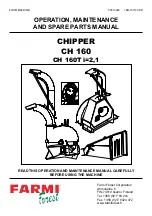
6
1.4 - Repair safety considerations
All installation parts must be maintained by the personnel in
charge, in order to avoid material deterioration and injuries
to people. Faults and leaks must be repaired immediately.
The authorized technician must have the responsibility to
repair the fault immediately. After each repair of the unit,
check the operation of the protection devices and create a
report of the parameter operation at 100%.
Comply with the regulations and recommendations in unit
and HVAC installation safety standards, such as: EN 378,
ISO 5149, etc.
If a leak occurs or if the refrigerant becomes polluted (e.g.
by a short circuit in a motor) remove the complete charge
using a recovery unit and store the refrigerant in mobile
containers.
Repair the leak detected and recharge the circuit with the
total R-407C charge, as indicated on the unit name plate.
Do not top up the refrigerant charge. Only charge liquid
refrigerant R-407C at the liquid line.
Ensure that you are using the correct refrigerant type before
recharging the unit.
Charging any refrigerant other than the original charge
type (R-407C) will impair machine operation and can even
destroy the compressors. The compressors operating with
this refrigerant type are lubricated with a synthetic polyol-
ester oil.
Never use air or a gas containing oxygen during leak tests to
purge lines or to pressurise a machine. Pressurised air
mixtures or gases containing oxygen can be the cause of an
explosion. Oxygen reacts violently with oil and grease.
Only use dry nitrogen for leak tests, possibly with an
appropriate tracer gas.
If the recommendations above are not observed, this can
have serious or even fatal consequences and damage the
installation.
Never exceed the specified maximum operating pressures.
Verify the allowable maximum high- and low-side test
pressures by checking the instructions in this manual and
the pressures given on the unit name plate.
Do not unweld or flamecut the refrigerant lines or any
refrigerant circuit component until all refrigerant (liquid
and vapour) as well as the oil have been removed from
chiller. Traces of vapour should be displaced with dry
nitrogen. Refrigerant in contact with an open flame
produces toxic gases.
The necessary protection equipment must be available,
and appropriate fire extinguishers for the system and the
refrigerant type used must be within easy reach.
Do not siphon refrigerant.
Avoid spilling liquid refrigerant on skin or splashing it
into the eyes. Use safety goggles and safety gloves. Wash
any spills from the skin with soap and water. If liquid
refrigerant enters the eyes, immediately and abundantly
flush the eyes with water and consult a doctor.
Never apply an open flame or live steam to a refrigerant
container. Dangerous overpressure can result. If it is
necessary to heat refrigerant, use only warm water.
During refrigerant removal and storage operations follow
applicable regulations. These regulations, permitting condi-
tioning and recovery of halogenated hydrocarbons under
optimum quality conditions for the products and optimum
safety conditions for people, property and the environment
are described in standard NF E29-795.
Any refrigerant transfer and recovery operations must be
carried out using a transfer unit. A 3/8” SAE connector on
the manual liquid line valve is supplied with all units for
connection to the transfer station. The units must never be
modified to add refrigerant and oil charging, removal and
purging devices. All these devices are provided with the
units. Please refer to the certified dimensional drawings for
the units.
Do not re-use disposable (non-returnable) cylinders or
attempt to refill them. It is dangerous and illegal. When
cylinders are empty, evacuate the remaining gas pressure,
and move the cylinders to a place designated for their
recovery. Do not incinerate.
Do not attempt to remove refrigerant circuit components
or fittings, while the machine is under pressure or while it
is running. Be sure pressure is at 0 kPa and that the unit
has been shut down and de-energised before removing
components or opening a circuit. If the refrigerant circuit
is open to carry out a repair, all circuit openings must be
plugged, if the repair takes longer than 30 minutes. This
prevents humidity from contaminating the circuit, especially
the oil. If the work is expected to take longer, charge the
circuit with nitrogen.
Do not attempt to repair or recondition any safety devices
when corrosion or build-up of foreign material (rust, dirt,
scale, etc.) is found within the valve body or mechanism.
If necessary, replace the device. Do not install safety valves
in series or backwards.
ATTENTION: No part of the unit must be used as a
walkway, rack or support. The refrigerant lines can break
under the weight and release refrigerant, causing personal
injury.
Do not climb on a machine. Use a platform, or staging to
work at higher levels.
Use mechanical lifting equipment (crane, hoist, winch,
etc.) to lift or move heavy components. For lighter
components, use lifting equipment when there is a risk of
slipping or losing your balance.







































